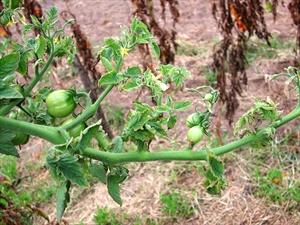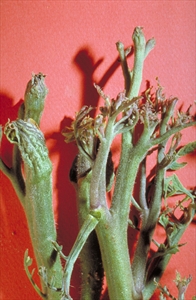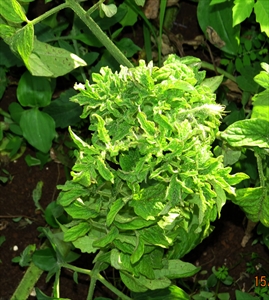Tomato big bud
Pacific Pests, Pathogens and Weeds - Online edition
Pacific Pests, Pathogens & Weeds
Tomato big bud (212)
Candidatus Phytoplasma aurantifolia; there are several strains of the phytoplasma identified in tomato throughout the world; the strain in the Pacific is in the phytoplasma group/subgroup coded 16SrII. This code refers to analysis of ribosomal RNA.
Uncertain. There are many other countries where tomato big bud has been reported, for instance, China, India, and other Asian countries, South Africa, and the USA, but the strains have not been reported. Tomato big bud (16SrII) was first recorded in Australia, It is reported from many Pacific Islands countries in many different plants, but only in New Caledonia from tomato. Big bud of unknown phytoplasma strain has also been recorded in tomato from Fiji.
Many cultivated plants (crops and ornamentals) and weeds are reported to be infected by the strain (16SrII) that is found in tomato; for instance, beach morning glory (Ipomoea pes-caprae subsp. basiliensis), Chinese cabbage, peanut, sweetpotato, and the weeds/ornamentals, Achyranthes, Celosia, Crotalaria, Cyanthillium, Emilia, and Polygala.
Leaves are small, curled upwards and yellowish-green or purple (Photo 1). Stems become erect, short, thick and purple (Photo2); flower buds become swollen, with green petals - hence the name of the disease - and normally dormant buds develop shoots. Green fruits are hard, tough and woody.
Plants infected early are bushy, because of the development of many branches (Photos 3&4).
Spread of the phytoplasma is by leafhoppers. One leafhopper that spreads tomato big bud is Orosius argentatus, but it is possible that there are other species. This leafhopper lives and breeds on weeds, and moves to tomato (and other crops) during dry times. Spread can be over long distances, during leafhopper migrations. There is very little spread of the phytoplasma within crops of tomato.
The phytoplasma survives in weeds, and in the bodies of the leafhoppers. Once leafhoppers become infected by feeding on a plant with phytoplasma, they remain infected for life.
Big bud is usually a minor disease on tomato. The usual situation is that only a few plants of a crop are infected and show symptoms, although instances are reported (but not from the Pacific islands) where 30-40% of plants were infected, and yields were low because fruits were absent or very small.
Look for the upward curled leaves, erect stems, and short thick shoots, with deformed leaves. Look for the swollen flowers, with green petals.
CULTURAL CONTROL
There are few ways to control phytoplasma diseases; if the damage is severe, it might be best to replant than suffer low yields.
Before planting:
- Remove any 'volunteer' tomato plants and weeds, especially those in the tomato family, from around nurseries and in and around field plots.
- Preferably, raise the tomato seedlings in a screenhouse or under an insect screen cover.
- Do not plant next to other susceptible crops, such as eggplant or capsicum.
After harvest:
- Collect the plants together with weeds around the planting and burn or bury them.
CHEMICAL CONTROL
The value of insecticides in the control of this disease is unclear. Migrating leafhoppers may infect plants before the insecticide kills them, and before infections have occurred. Those recommended against plant hoppers on taro may have potential (see Fact Sheet no. 41).
____________________
When using a pesticide, always wear protective clothing and follow the instructions on the product label, such as dosage, timing of application, and pre-harvest interval. Recommendations will vary with the crop and system of cultivation. Expert advice on the most appropriate pesticide to use should always be sought from local agricultural authorities.
AUTHOR Grahame Jackson
Information from Diseases of vegetable crops in Australia (2010). Editors, Denis Persley, et al. CSIRO Publishing; and from D Blancard (2012) Tomato diseases - Identification, Biology and Control. Manson Publishing Ltd., London NWI11 7DL, UK. Photos 2&4 Kohler F, et al. (1997) Diseases of cultivated crops in Pacific Island countries. South Pacific Commission. Pirie Printers Pty Limited, Canberra, Australia. Photo 3 Sione Foliaki, Deputy Director and Head of Agricultural Research and Information Division, MAF, Tonga.
Produced with support from the Australian Centre for International Agricultural Research under project PC/2010/090: Strengthening integrated crop management research in the Pacific Islands in support of sustainable intensification of high-value crop production, implemented by the University of Queensland and the Secretariat of the Pacific Community.







